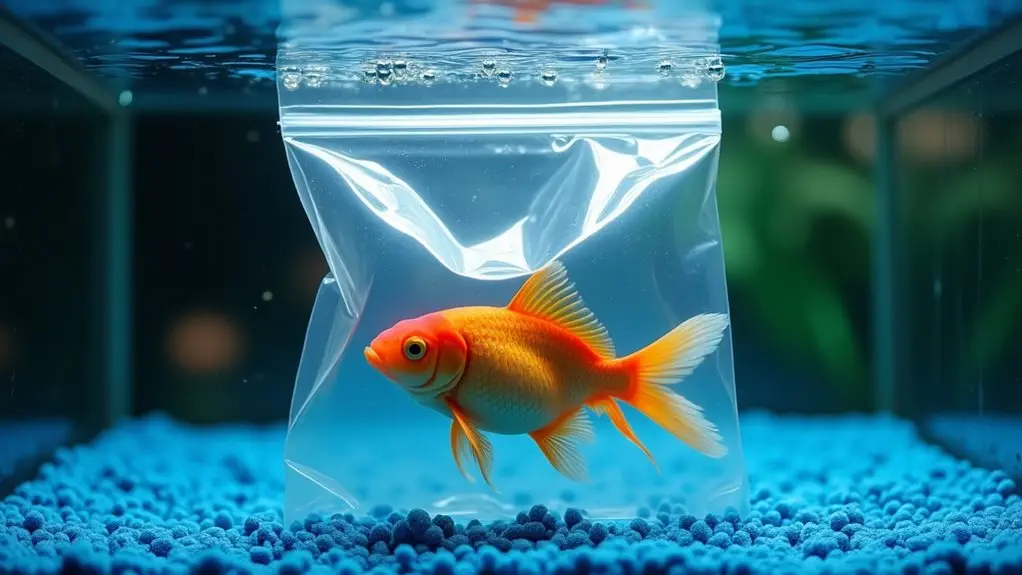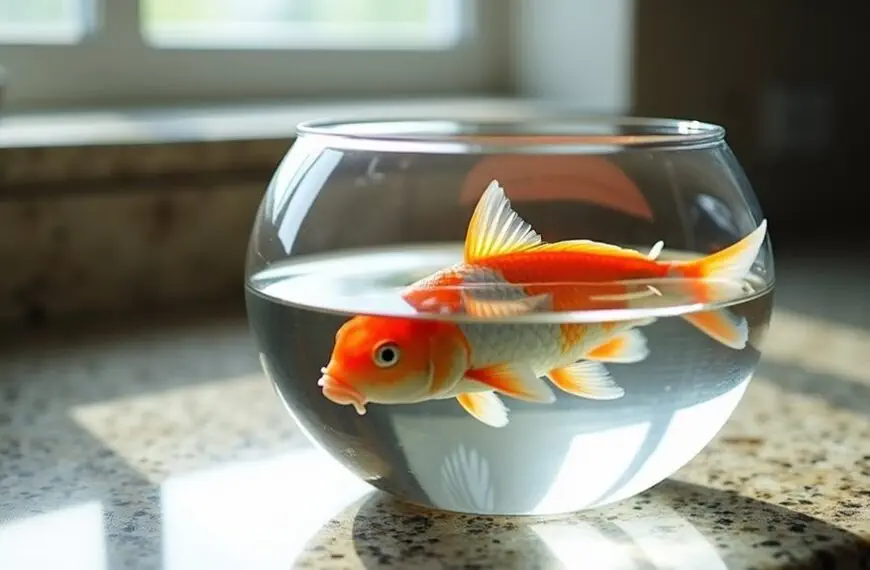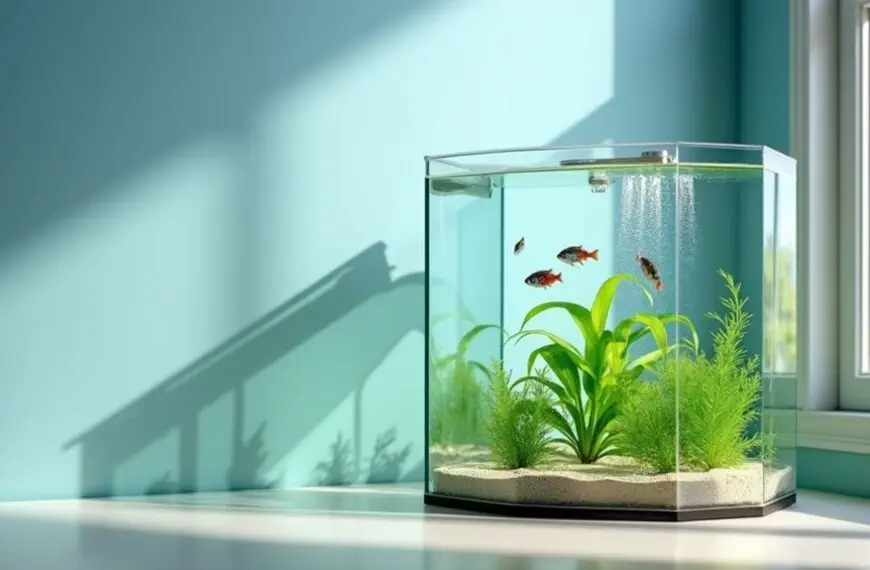To safely move fish from a bag to your tank, you'll need to acclimate them properly to prevent shock. Float the sealed bag in your aquarium for 15-30 minutes to match water temperatures, then dim the lights to reduce stress. Every 5 minutes, add small amounts of tank water to the bag, helping your fish adjust to the new water parameters. After about 30 minutes, use a clean net to gently transfer your fish to the tank, being careful not to pour the bag water in. Watch for normal swimming and breathing patterns in the first few hours – there's much more to successful fish transfers than meets the eye.
Contents
- 1 Essential Equipment and Supplies
- 2 Understanding Water Parameters
- 3 Bag Preparation Steps
- 4 Temperature Matching Process
- 5 Safe Water Addition Methods
- 6 Fish Behavior During Acclimation
- 7 Transferring Fish Successfully
- 8 Common Acclimation Mistakes
- 9 Special Cases and Exceptions
- 10 Follow-Up Care After Transfer
- 11 Frequently Asked Questions
- 12 Final Thoughts
Essential Equipment and Supplies
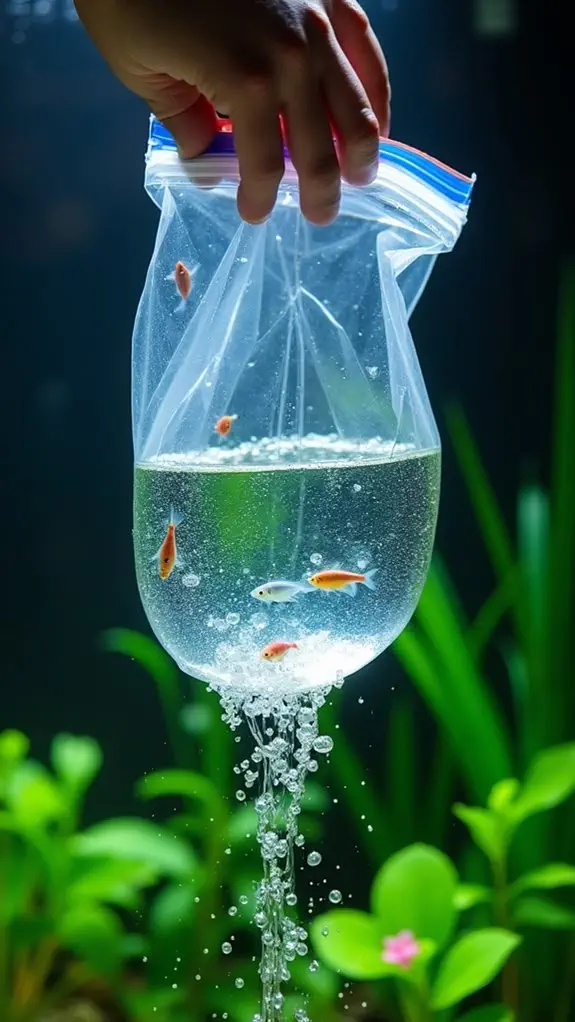
Every successful fish transfer begins with the right equipment and supplies. When you're transporting fish, you'll need several essential items to guarantee your finned friends make it safely to their new home.
Start with clean five-gallon buckets, which are perfect for moving both fish and aquarium water without any risk of contamination from chemical residues. Adding stress coat conditioner to the buckets helps reduce fish mortality during transport. For optimal safety, double bagging provides an extra layer of protection against leaks and tears. Additionally, ensure you've properly established tank cycling prior to introducing your fish to minimize stress.
For your aquarium supplies checklist, make certain you've got poly plastic bags for shorter moves, a reliable fish net for gentle scooping, and a siphon hose to transfer water efficiently.
If you're planning a longer journey, you'll definitely want to invest in an air pump to keep oxygen levels stable – your fish will thank you! Don't forget to grab some duct tape to secure those air pump tubes and bucket lids.
You'll also want to prepare your buckets properly by drilling small holes in the lids for air tubing and adding air stones to maintain proper oxygen circulation.
For extra protection during transport, keep some bubble wrap and foam sheets handy to cushion your equipment.
Understanding Water Parameters
Before you introduce your new fish to their home, you'll need to check that the water parameters match their specific needs, including pH, temperature, hardness, and salinity.
You can't skip testing for ammonia and nitrate levels, as these invisible chemicals can harm your fish even if the water looks crystal clear. Regular testing and monitoring helps prevent costly disasters if parameters start to drift. To ensure a healthy environment, it's crucial to maintain ammonia at 0 ppm, as even low levels can lead to distress.
Your goal is to match the tank's conditions to what's in the transport bag, making sure there aren't any dramatic swings that could stress out your finned friends. Testing the pH 1-2 times weekly will help maintain optimal conditions for your fish.
Ph and Temperature Testing
Understanding your aquarium's water parameters is vital for successful fish acclimation. When you're moving fish to a new tank, you'll need to monitor both pH fluctuations and temperature stability closely to guarantee your finned friends shift safely.
For pH testing, you've got several options at your disposal. While liquid test kits are popular, they're not always the most accurate in acidic conditions. If you're serious about precision, consider investing in a quality electronic pH meter – yes, they're pricier, but your fish will thank you! Regular calibration is essential for reliable electronic meter performance. Remember to calibrate your meter regularly for reliable readings.
Temperature testing is equally important, and you'll want to keep a close eye on those numbers. Digital thermometers are your best friend here – they're easy to read and more accurate than their old-school glass counterparts. Sticker strip thermometers should be avoided due to their inaccuracy.
Aim to maintain temperatures between 75.2°F and 86°F, depending on your fish species. Think of it like keeping your fish's living room at the perfect comfort level!
Don't forget that both pH and temperature changes can stress your fish, leading to rapid breathing and other signs of discomfort. Regular monitoring helps you catch any issues before they become problems.
Water Hardness and Salinity
When moving fish to a new tank, water hardness and salinity levels can make or break your success. These parameters aren't just fancy terms – they're essential factors that directly affect your fish's health and ability to adapt to their new home. Regular water quality checks prevent toxic buildup, ensuring a healthy environment for your fish.
You'll need to pay special attention to both general hardness (GH) and carbonate hardness (KH) to guarantee your finned friends shift smoothly. Test kits provide the most reliable way to measure these parameters. For neutral tanks, aim to maintain 4 to 8 dGH as the ideal general hardness range.
Think of water hardness as your fish's comfort zone – it's like moving from a soft, cozy bed to a rock-hard mattress if you don't get it right! Your fish need time to adjust to any differences between their transport water and your tank water. Testing the water parameters frequently can help ensure a smoother transition.
The salinity effects can be particularly stressful for fish, as they're constantly working to maintain their internal mineral balance. That's why you'll want to float the bag and gradually add tank water to it, allowing your fish to adjust to any changes in hardness levels.
Ammonia and Nitrate Levels
Just as you'd check the temperature before diving into a pool, monitoring ammonia and nitrate levels is essential for your fish's survival during transfer.
Before introducing your new fish, you'll want to verify your tank's ammonia levels are at zero and nitrates are below 20 ppm, creating a safe environment for your aquatic friends. Maintaining low nitrate levels can be aided by implementing regular water changes, which help dilute harmful substances and keep conditions stable.
Don't skip ammonia testing during the acclimation process – even a small spike above 0.25 ppm can stress your fish.
Think of ammonia as the underwater equivalent of air pollution; you wouldn't want your fish gasping in toxic water! Regular testing helps you catch problems before they become serious, and you can quickly perform a partial water change if levels creep up. Higher pH levels can make ammonia more toxic to your fish.
Using an API Master Test Kit will give you the most accurate readings of your water parameters.
For effective nitrate management, keep those levels under 80 ppm, though lower is always better.
Your fish will thank you by staying healthy and active. If you're keeping live plants, they'll actually help keep nitrates in check, working as nature's own filtration system.
Bag Preparation Steps
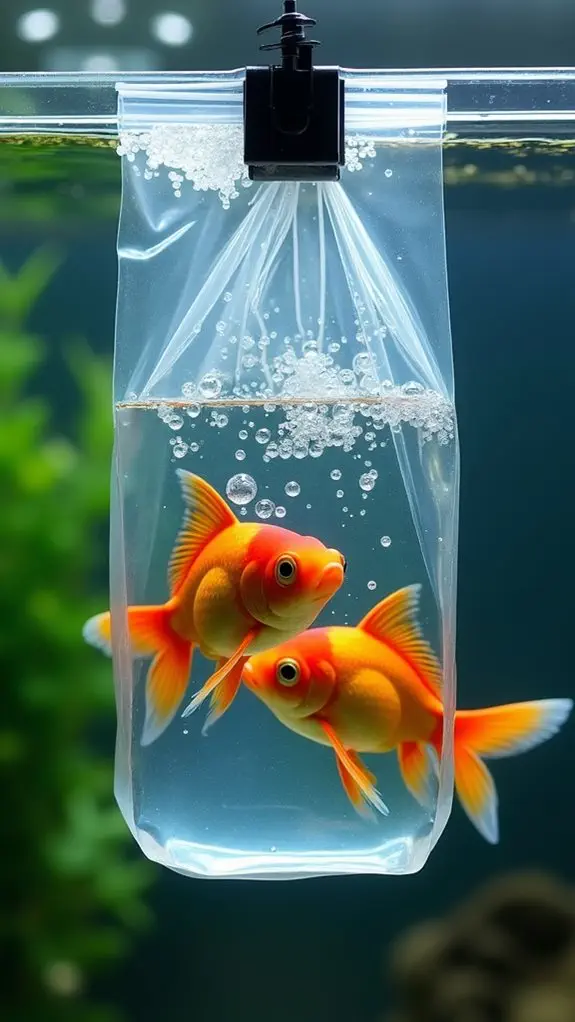
Proper bag preparation serves as the foundation for safely transporting your fish to their new home. When you're getting ready to move your aquatic friends, start by selecting the right bag sizing – you'll want one that's sturdy and gives your fish enough room to move comfortably. Think of it as booking a first-class seat rather than cramming them into economy!
Fill the bag with water from your tank, but don't go overboard – you'll want to leave about one-third of space at the top. For longer journeys, oxygen enrichment is essential to keep your fish breathing easy. You can add pure oxygen to the bag, but if you're making a quick trip under an hour, the air space should suffice.
Don't forget to double-bag for extra protection – it's like giving your fish a safety belt and airbag combo! Remember to seal everything securely with rubber bands or knots, and inspect for any sneaky leaks before you start moving.
Keep the bag upright during transport, and if you're dealing with sensitive species, wrap them in some insulation – think of it as a cozy travel blanket for your finned friends.
Temperature Matching Process
After securing your fish in their transport bag, the next step focuses on matching water temperatures – a process that can make or break your fish's successful introduction to their new home.
Start by floating the sealed bag in your aquarium for about 15-30 minutes, which allows for gentle temperature balancing between the bag and tank water.
You'll want to turn off your aquarium lights during this process to prevent any unwanted warming of the bag water.
While you're waiting, keep an eye out for stress indicators in your fish – if you notice rapid breathing or unusual color changes, don't panic! Simply remove the bag from the tank, wait five minutes, and try again.
During the temperature matching process, you'll need to test both the shipping water and tank water parameters.
If you notice significant differences, you might need to extend the floating time or consider using a quarantine system to bridge the gap.
Think of it as introducing your fish to their new home's climate – you wouldn't want to rush from a cozy room into freezing weather, and neither do they!
Additionally, ensure that the parameters of the new tank are stable, as a well-cycled tank is essential for healthy aquatic environments to support your new fish comfortably.
Safe Water Addition Methods
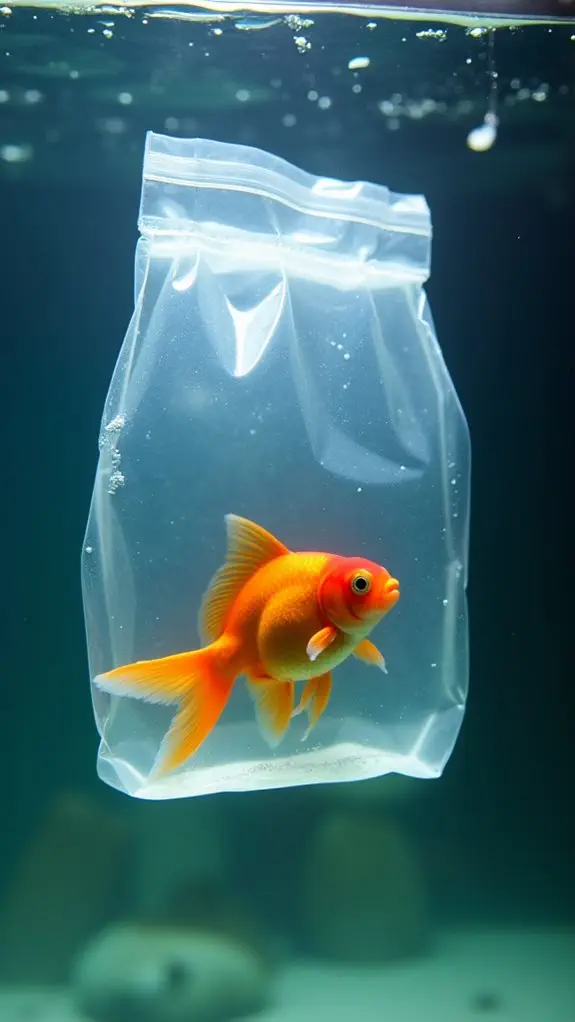
The safe addition of water to your aquarium requires careful preparation and execution to protect your fish's health. Before adding any water, you'll need to treat it with a water conditioner to neutralize harmful chemicals like chlorine and heavy metals. Think of it as creating a cozy, safe environment for your underwater friends!
To add water without disturbing your tank's ecosystem, place filter foam squares over the substrate – they'll act like tiny umbrellas, dispersing the water flow gently. You'll want to pour or siphon the water slowly, almost as if you're serving tea at a fancy dinner party.
Don't forget to add beneficial bacteria products like API® QUICK START™ to maintain a healthy nitrogen cycle. Proper water quality management is crucial for avoiding stress and illness in your fish.
Different water types need different approaches. If you're using tap water, it's usually fine after conditioning, but distilled or reverse osmosis water needs remineralization – they're like blank canvases that need some color added back in.
Remember to monitor your water parameters regularly, and make adjustments gradually. Your fish will thank you by staying healthy and active in their well-maintained home!
Fish Behavior During Acclimation
During acclimation, your fish will display various behaviors that signal their stress levels and adaptation progress.
You'll notice behavior changes ranging from rapid breathing to color variations, much like how we might feel anxious in a new environment. It's crucial to monitor these stress signals closely to guarantee your finned friends are adjusting well to their new home.
Here are the key behaviors you should watch for during acclimation:
- Breathing patterns – If your fish is breathing rapidly or seems to be gasping, they're likely experiencing stress from temperature or water quality differences.
- Swimming activity – Watch for erratic movements, hiding, or unusual lethargy.
- Color changes – Stress can cause fish to become pale or develop unusual spots.
- Feeding response – Initially, they might refuse food, which is normal for the first day.
Keep the lights dim and maintain a peaceful environment while your fish adjust.
It's important to note that maintaining optimal dissolved oxygen levels is crucial for reducing stress during this period.
You'll know they're settling in when they start exploring their surroundings, interacting naturally with tank mates, and showing interest in food.
Transferring Fish Successfully
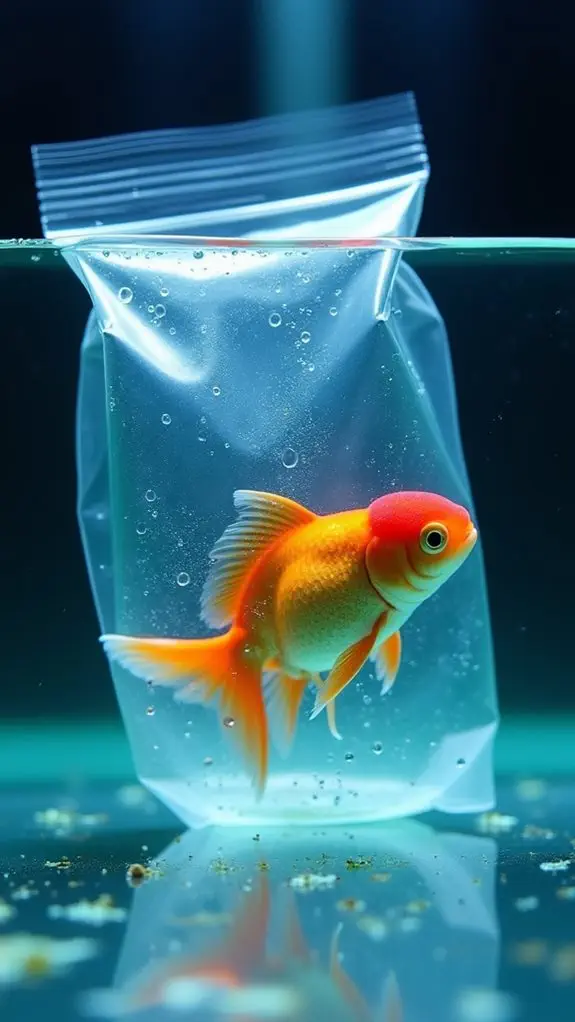
Now that you've observed your fish's behavior during acclimation, it's time to move them safely into their new home. For ideal fish compatibility and stress reduction, you'll want to carefully execute this final stage of the transfer process.
Start by gently netting your fish from the acclimation bag – and here's a pro tip: don't dump that bag water into your tank! You'll want to discard it to prevent any unwanted hitchhikers or contaminants from joining your aquatic family.
Release your fish slowly into a calmer area of the tank, away from strong currents or bubbling filters that might overwhelm them.
Keep a close eye on your new swimmers for the next few hours. They might play a game of hide-and-seek at first – that's totally normal! Additionally, make sure the water parameters, such as ammonia levels(#), are appropriate to keep your fish healthy during this transition.
Make sure your tank's filtration and lighting are working properly, and watch for any signs that your fish aren't feeling their best, like rapid breathing or unusual color changes.
If you're introducing multiple fish, verify they've enough space to establish their territories without bumping into each other like underwater bumper cars.
Common Acclimation Mistakes
When you're excited to add new fish to your tank, it's tempting to rush through the acclimation process, but this common mistake can seriously harm your aquatic friends.
You'll also want to avoid focusing only on water temperature, as there's much more to proper acclimation than just matching degrees.
While temperature is important, you'll need to take into account other factors like pH and salinity to give your fish the best chance at thriving in their new home. Regular pH testing is essential to ensure that the water conditions are stable and appropriate for your new fish.
Rushing The Process
Rushing the acclimation process can be fatal for your new fish, as sudden changes in water chemistry and temperature often lead to shock, stress, and even death.
When it comes to stress management, you'll want to take your time and guarantee proper acclimation timing to protect your finned friends.
Here's what happens when you rush the process:
- Your fish's immune system becomes compromised, making them more susceptible to diseases and infections.
- They'll likely exhibit erratic swimming patterns and heavy breathing as their bodies struggle to adapt.
- Their ability to regulate bodily functions becomes impaired, affecting everything from digestion to oxygen absorption.
- The sudden change in water parameters can cause severe physiological stress that may not be immediately visible.
- It is critical to ensure that water quality parameters are stable during the acclimation process to prevent any undue stress on your new fish.
Temperature Only Focus
Many aquarists fall into the trap of focusing solely on temperature during fish acclimation, overlooking equally important water parameters. While it's true that temperature matching is vital, your fish's survival depends on much more than just getting the warmth right.
You wouldn't want to move into a house that's the perfect temperature but has unbreathable air, would you?
Here's what you need to know: fish actually show higher pH sensitivity than temperature sensitivity, and sudden pH changes can be more harmful than slight temperature variations.
When you're moving fish from a lower pH environment to a higher one, you're fundamentally asking them to adjust their entire body chemistry. It's like asking you to suddenly breathe different air – not very comfortable!
Don't forget about salinity importance, either. Your fish need time to adjust to changes in salt levels, just as they do with temperature.
Instead of solely floating the bag, take a balanced approach by gradually introducing your tank water to match all parameters.
Think of it as helping your fish adjust to their new home's entire environment, not just the thermostat setting.
Special Cases and Exceptions
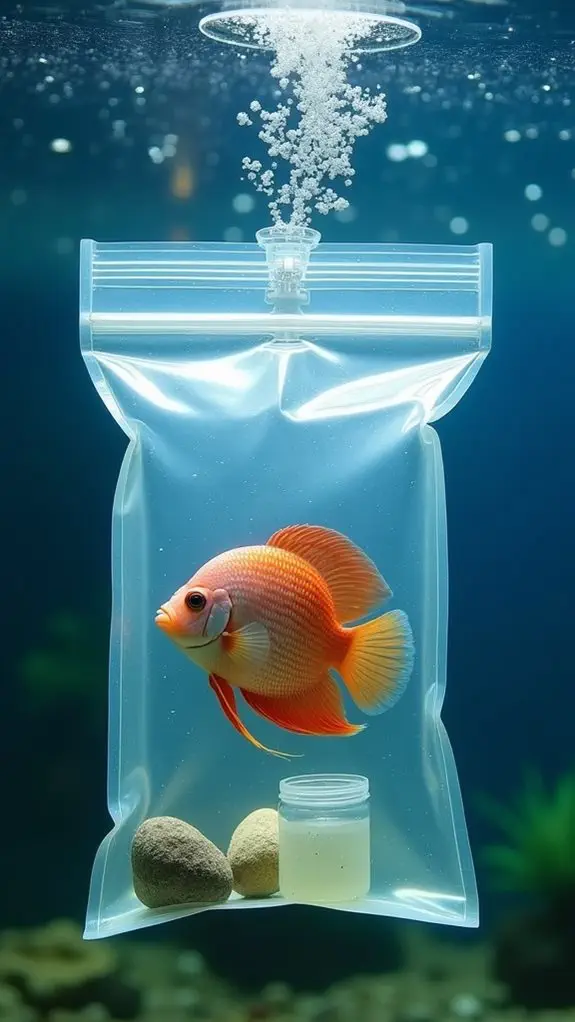
Experienced aquarists understand that different moving scenarios require specific approaches to protect their fish. When you're planning a long-distance move, you'll need to take into account using buckets instead of bags, as they provide a more stable environment and can hold more water.
Don't forget to use new, clean buckets and add air pumps to guarantee your finned friends have enough oxygen during their journey.
For sensitive fish, you'll want to take extra precautions. Skip the nets and opt for gentle cup transfers, giving them plenty of time to acclimate to their new home.
Here are four essential tips for handling special cases:
- Use individual bags for larger fish, guaranteeing they've enough space to move comfortably.
- Fill containers only one-third to three-quarters full to prevent spilling during transport.
- Extend the acclimation period for sensitive species by floating them longer in the new tank.
- Avoid adding new tank mates close to moving day to maintain stable water chemistry.
Follow-Up Care After Transfer
After you've moved your fish to their new home, you'll want to keep a close eye on them for signs of stress or unusual swimming patterns.
It's essential to check your water parameters twice daily for the first few days, making sure ammonia, nitrites, and pH levels stay within the safe range.
You're not just being an overprotective fish parent – these first 48 hours are vital for your finned friends' successful adjustment to their new environment.
Monitor For Unusual Behavior
Successful fish transfers require vigilant monitoring of your fish's behavior in the following days and weeks.
You'll want to watch for behavioral changes and stress indicators that might suggest your fish isn't adjusting well to its new environment. Keep an eye on swimming patterns, appetite, and social interactions, as these can tell you a lot about your fish's well-being.
Here are key behaviors you should monitor:
- Swimming patterns – Look for unusual depth changes or if your fish stays at the tank bottom more than usual.
- Eating habits – Watch if your fish maintains normal appetite and feeding routines.
- Social behavior – Notice how your fish interacts with tank mates and responds to movement outside the tank.
- Physical condition – Check for any visible injuries or signs of stress.
Don't worry if you notice slight changes in the first few days – that's normal!
However, if unusual behavior persists, you'll need to take action. Using tools like acoustic telemetry or automated monitoring systems can help you track these changes more effectively.
Water Parameter Double-Check
Maintaining stable water parameters is essential in the days following your fish transfer. You'll need to perform daily water testing to verify your aquatic friends are swimming in safe conditions. Use an API Master Test Kit to monitor ammonia, nitrite, and nitrate levels closely – think of it as giving your fish a daily health check-up!
During the first few weeks, keep ammonia levels below 0.25 ppm and watch for any concerning spikes. If you notice levels creeping up, don't panic – a partial water change can help restore parameter stability.
Remember to maintain your pH between 7.8-8.3 and temperature between 76-83°F – your fish will thank you for this comfort zone!
For long-term success, run both old and new filters together for 4-6 weeks. This might seem like overkill, but it's like having a backup generator for your beneficial bacteria!
Don't forget to use API Stress Coat during water changes, and consider adding API Quick Start to boost your biological filtration. Keep detailed records of your readings – you'll be amazed at how this simple habit can help you spot and prevent potential issues before they become problems.
Frequently Asked Questions
How Long Can Fish Safely Stay in the Shipping Bag?
You can keep your fish in shipping bags for up to 72 hours, but you'll want to minimize transport time. After that, water quality deteriorates rapidly, putting your fish at risk of stress or death.
Should I Feed My Fish Before or After Acclimation?
Don't feed your fish before acclimation. Wait 24-48 hours after acclimation timing to start your feeding schedule. Your fish will be less stressed and better able to adjust to their new environment.
Can I Acclimate Multiple Species of Fish Together?
You shouldn't acclimate multiple species together due to compatibility considerations and stress factors. It's best to use separate containers for each species to prevent cross-contamination and monitor individual responses during acclimation.
What if My Fish Becomes Stuck in the Bag?
If your fish gets stuck, don't panic. Gently manipulate the bag to create more space for fish rescue. You can carefully shake it or use a soft tool for bag removal without harming your fish.
How Soon After Acclimation Can I Turn on Aquarium Lights?
You'll want to keep lights off for 2-4 hours after acclimation. Watch your fish's behavior for signs of stress. Then gradually increase light duration over the next few hours for a smoother changeover.
Final Thoughts
By following these careful steps for moving your fish from bag to tank, you'll give your aquatic friends the best chance at a smooth adjustment to their new home. Remember, patience is key – rushing the process can stress your fish unnecessarily. You've learned the essentials of proper acclimation, from matching temperatures to avoiding common mistakes. Now you're ready to welcome your fish to their new underwater paradise with confidence.

